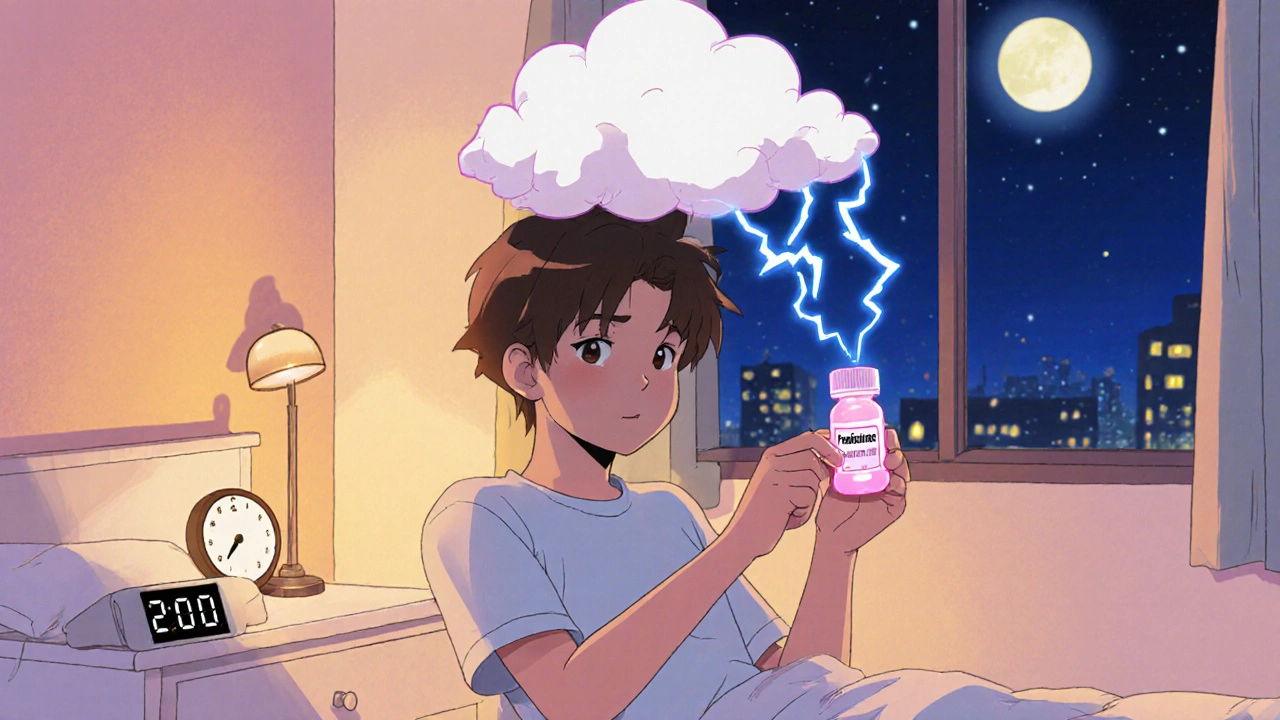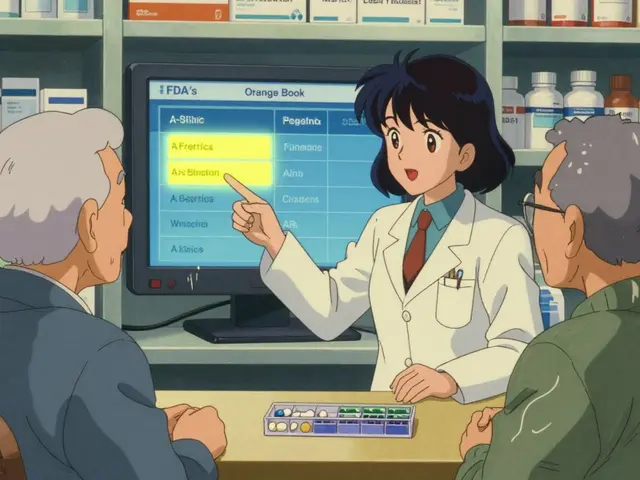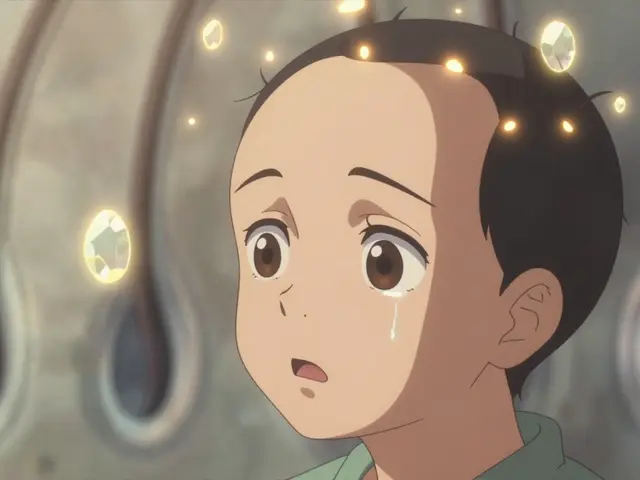
Prednisone Mood Tracker
Daily Mood Log
Mood Trends
Tips for Tracking
Log your mood daily, especially during the first 2 weeks of prednisone treatment. Note patterns that correspond with your medication schedule. Share this data with your healthcare provider at your next appointment.
When doctors prescribe Prednisone is a synthetic corticosteroid that suppresses the immune system and reduces inflammation. it’s a lifesaver for conditions ranging from rheumatoid arthritis to severe allergic reactions. But many patients notice a sudden shift in emotions - irritability, anxiety, or even depressive episodes - within days of starting therapy. If you’ve ever wondered why the medication that eases your physical pain can stir up a storm inside your head, you’re in the right place. This guide walks you through the science, the warning signs, and concrete steps you can take to stay emotionally steady while on prednisone.
Why Prednisone Can Flip Your Mood
Prednisone mimics cortisol, the body’s natural stress hormone. By binding to glucocorticoid receptors in the brain’s limbic system, it directly influences serotonin and dopamine pathways - the chemicals that regulate mood, anxiety, and motivation. Neuroimaging studies show altered activity in the amygdala and prefrontal cortex within 72 hours of a new dose, which explains why mood changes can appear "straight away" for many users. The drug’s molecular structure (C21H28O5) lets it cross the blood‑brain barrier in under an hour, so the brain feels the impact almost as quickly as the rest of the body.
How Common Are These Mood Swings?
Large‑scale analyses paint a clear picture: between 18 % and 47 % of patients on corticosteroids report some form of psychiatric side effect. The U.S. FDA labels mood changes as a "very common" side effect, meaning they occur in more than 10 % of users. A 2019 meta‑analysis in the American Journal of Psychiatry found mood disturbances to be the most frequently cited symptom, especially in the first two weeks of treatment. Higher daily doses (>20 mg) raise the risk dramatically - a 2021 study reported a 3.2‑fold increase in mood problems at 40 mg versus 10 mg.
Red Flags: What to Watch For
- Sudden irritability or anger that feels out of character
- Increased anxiety, racing thoughts, or panic attacks
- Periods of elevated energy, reduced need for sleep, or pressured speech (often described as "bipolar‑like")
- Feelings of hopelessness, loss of interest, or thoughts of self‑harm
- Confusion, disorientation, or delirium - especially in older adults
If any of these symptoms appear within the first week of starting prednisone, note the timing and severity. A mood diary can help you and your healthcare team see patterns and decide on interventions.
Who’s Most at Risk?
Several factors raise the odds of experiencing mood swings:
- Dose size: >20 mg daily significantly ups the chance of psychiatric effects.
- Pre‑existing mental health conditions: A history of depression, bipolar disorder, or anxiety can magnify steroid‑induced changes.
- Age: Older adults are more prone to delirium, while younger patients may swing toward hypomania.
- Duration of therapy: Prolonged courses (>2 weeks) maintain higher hormone levels in the brain.
- Rapid dose escalation: Jumping from a low to a high dose without a gradual increase can shock the nervous system.
Everyday Coping Strategies Backed by Research
Below is a practical toolbox. Each item has been linked to peer‑reviewed evidence or reputable clinical guidelines.
| Strategy | Why It Helps | Supporting Evidence |
|---|---|---|
| Consistent Sleep Schedule | Stabilizes circadian rhythm disrupted by glucocorticoids | Journal of Psychiatric Research, 2022 - 27 % cortisol reduction with regular sleep |
| 30‑minute Moderate Exercise Daily | Lowers endogenous cortisol, releases endorphins | American Psychological Association, 2023 - exercise mitigates steroid mood effects |
| Mood Journal | Identifies triggers, facilitates communication with clinicians | Crohn's & Colitis Foundation, 2022 - 43 % reported reduced severity |
| Mindfulness Meditation (15 min twice daily) | Activates prefrontal regulation, reduces amygdala reactivity | Clinical guidelines, 2023 - mindfulness cuts anxiety scores by 22 % |
| Cognitive‑Behavioral Therapy (CBT) techniques | Reframes negative thoughts, builds coping skills | APA Clinical Guidelines, 2023 - CBT effective for medication‑induced mood disorders |
| Schedule Important Decisions for Morning Doses | Medication peaks later in the day; morning dosing means lower brain levels when you need to think clearly | Patient anecdotal data, MyCrohnsAndColitisTeam, 2023 |
Pick the tactics that fit your lifestyle. Most patients see noticeable improvement after a week of consistent practice.

Medical Support: When Lifestyle Isn’t Enough
Talking to your prescriber should be the first step if mood changes feel unmanageable. Options they may discuss include:
- Dosage taper: Reducing the dose as quickly as clinically safe can curb psychiatric symptoms without sacrificing disease control.
- Switching to a steroid‑sparing regimen: Biologics or disease‑modifying agents may replace high‑dose prednisone in many autoimmune conditions.
- Prophylactic SSRIs: Low‑dose selective serotonin reuptake inhibitors have cut mood swing incidence by 58 % in a 2024 trial, though this is off‑label.
- Psychiatric referral: A psychiatrist can assess whether symptoms meet DSM‑5 criteria for a substance‑induced mood disorder and prescribe short‑term anxiolytics or mood stabilizers if needed.
- Emergency care: Suicidal thoughts, severe agitation, or psychosis require immediate evaluation - call 911 or go to the nearest emergency department.
The American Gastroenterological Association recommends limiting any dose above 20 mg to no more than 14 days when possible, precisely to reduce these psychiatric risks.
Practical Checklist for Patients & Caregivers
- Write down the exact start date, dose, and schedule of prednisone.
- Track mood, sleep, appetite, and anxiety levels daily - note any spikes.
- Set a regular bedtime and wake‑time; avoid caffeine after noon.
- Fit in at least 30 minutes of brisk walking, cycling, or swimming.
- Spend 10‑15 minutes on guided mindfulness (apps like Headspace work well).
- Schedule crucial conversations (work, legal, medical) for the morning when steroid levels are lowest.
- Share your mood journal with your doctor at each visit.
- Know the red‑flag symptoms that need urgent help (suicidal thoughts, severe confusion).
Having this checklist on your fridge or phone can make a big difference when emotions run high.
Support Networks - You’re Not Alone
Connecting with others who understand prednisone’s emotional rollercoaster can reduce isolation. Online communities such as r/prednisone on Reddit, MyCrohnsAndColitisTeam forums, and the Crohn’s & Colitis Foundation’s patient groups often share coping hacks that aren’t in any textbook. If you’re comfortable, tell close family members about the potential side effects; a supportive environment can buffer irritability and help you stay accountable to your coping plan.
When to Seek Immediate Help
Even with the best strategies, some mood changes become dangerous. Call emergency services or go to the nearest hospital if you notice:
- Thoughts of self‑harm or suicide
- Severe agitation that threatens personal safety
- Rapidly fluctuating moods that impair daily functioning
- Hallucinations, delusions, or disorientation
Prompt medical attention can prevent a crisis and allow your care team to adjust treatment safely.
Bottom Line
Prednisone saves lives, but its impact on the brain is real and often rapid. By recognizing the signs early, using evidence‑based lifestyle tricks, and staying in close contact with your healthcare providers, you can keep the emotional side effects under control. Remember, you don’t have to ride the storm alone - tools, professionals, and peer groups are all there to help you stay steady.

How soon after starting prednisone can mood swings appear?
Most patients notice changes within the first 5‑7 days, although some may experience mood shifts as early as the first 24‑48 hours.
Are low‑dose prednisone prescriptions (<10 mg) safe for mood?
Even low doses can affect sensitive individuals, but the risk drops significantly. Monitoring is still recommended, especially if you have a prior psychiatric history.
Can I prevent mood swings by taking an antidepressant before starting prednisone?
Prophylactic SSRIs have shown a 58 % reduction in mood‑related side effects in a 2024 trial, but this use is off‑label. Discuss it with your doctor to weigh benefits and risks.
What lifestyle changes help the most?
A regular sleep schedule, daily moderate exercise, mindfulness meditation, and keeping a mood journal consistently rank highest in patient surveys and clinical studies.
When should I call emergency services?
If you experience suicidal thoughts, severe agitation, hallucinations, or any sign of psychosis, seek immediate medical help - call 911 or go to the nearest ER.





13 Comments
Hey there, if you’re wrestling with the emotional roller‑coaster that prednisone can throw at you, you’re definitely not alone.
First, give yourself credit for even noticing the shifts – that awareness is the first line of defense.
Try keeping a simple mood diary: jot down the time you take your dose, any headaches, sleep hours, and how you feel emotionally before and after.
When you see a pattern, you’ll be able to point it out to your doctor without feeling embarrassed.
Make sleep a non‑negotiable priority; go to bed and wake up at the same time every day, and keep screens out of the bedroom to protect your circadian rhythm.
Pair that routine with a short walk or light jog in the morning – the endorphins you release can counteract the cortisol surge from the meds.
Even 15 minutes of mindful breathing or a guided meditation app can quiet the amygdala and give the pre‑frontal cortex a breather.
If you have a supportive friend or family member, let them know you might be extra irritable; a heads‑up can prevent misunderstandings and give you a safety net.
They’re hiding the real side‑effects, and you’re buying the lie.
Look, the problem isn’t the drug, it’s the global pharma lobby pushing steroids like candy to keep us dependent.
We’re being medicated into complacency while they line their pockets, and anyone who points that out gets labeled a conspiracist.
America’s greatness lies in questioning authority, not in mindlessly swallowing pills manufactured overseas.
Ask your physician why they can’t prescribe something safer before you become a pawn in their profit scheme.
Hey Stephen, I hear your concerns, but the data shows that when prednisone is used responsibly, many patients avoid flare‑ups that would otherwise cripple them.
Balancing the benefits with the risks is a nuanced dance, not a black‑and‑white conspiracy.
Let’s keep the conversation centered on evidence and patient empowerment rather than blanket accusations.
Okay, I’m just gonna give a quick tip – set a timer for your meds and try to take them with food.
It helps cut the jittery feeling and keeps your stomach from doing somting weird.
Also, keep a water bottle handy; staying hydrated can calm the brain’s over‑reaction.
From a clinical standpoint, studies consistently report that a regular sleep schedule can lower cortisol by roughly 27 % (Journal of Psychiatric Research, 2022).
In addition, moderate aerobic exercise performed daily has been shown to reduce steroid‑induced mood swings by up to 30 % (APA, 2023).
Combining these two interventions creates a synergistic effect, stabilizing both the limbic system and pre‑frontal cortex, which translates to fewer irritability spikes.
Patients who adopt both strategies typically report noticeable improvement within the first week of implementation.
While your enthusiasm for quantifiable outcomes is commendable, it is imperative to acknowledge that individual pharmacokinetics can render generalized statistics less applicable.
Consequently, clinicians must tailor tapering regimens to each patient’s metabolic profile, ensuring both efficacy and safety.
Alright, squad, strap in – you’ve got the tools, now it’s time to execute.
Kick off each morning with a brief mindfulness sprint (think 5‑minute guided focus) before the dose hits peak, then hit the gym for a solid 30‑minute HIIT session to burn off that cortisol surge.
Remember, the brain loves predictability, so lock down a consistent bedtime and you’ll keep the emotional turbulence at bay.
And if you ever feel the mood dip creeping in, drop a quick note in your journal – data beats drama every time.
Your approach is solid, but keep the journal brief; a bullet‑point format works best for quick reviews.
Yo, real talk – if you’re feeling the mood swings, don’t just push through.
Take a breather, grab a coffee (no caffeine after noon), and chat with a friend about what’s up.
Sometimes a simple convo can reset the whole vibe.
Look, I get the casual vibe you’re going for, but let’s unpack why that advice, while well‑meaning, might not hit the mark for every patient.
First off, caffeine tolerance varies wildly; for some, a single afternoon cup can amplify anxiety levels due to adenosine receptor antagonism, essentially feeding the steroid‑induced jitter.
Second, the suggestion to “grab a coffee” neglects the pharmacodynamic interaction between glucocorticoids and the hypothalamic‑pituitary‑adrenal (HPA) axis, which can be further destabilized by additional stimulants.
Third, encouraging “just chat with a friend” assumes a robust social support system, which many users lack – leading to feelings of isolation when the advice falls flat.
In practice, a more nuanced plan would involve an individualized caffeine audit, perhaps swapping the coffee for a low‑caffeine herbal tea in the afternoons, and coupling that with scheduled tele‑health check‑ins for those without immediate social resources.
By tailoring the approach, we respect both the biochemical realities of prednisone and the psychosocial diversity of its users, ultimately reducing the risk of exacerbated mood swings.
Data shows that mood volatility correlates with dose magnitude, yet many patients dismiss this as “just a side effect.”
It’s critical to treat these signals as red flags, not background noise, and push for a prompt dose reassessment.
If your provider hesitates, request a steroid‑sparing alternative and document every emotional episode for a solid case.
Let’s keep the focus on actionable steps and avoid getting tangled in blame – progress is possible.